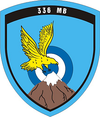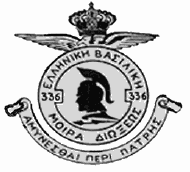336th Bomber Squadron (HAF)
| 336th Bomber Squadron 336 Μοίρα Βομβαρδισμού |
|
|---|---|

The badge of 336 Bomber Sq.
|
|
| Active | 25 February 1943- |
| Country |
|
| Branch | Hellenic Air Force |
| Role | Bomber |
| Part of | 116th Combat Wing |
| Garrison/HQ | Araxos Air Base |
| Motto(s) | fly low hit hard |
| No. 336 (Greek) Squadron RAF | |
|---|---|

The emblem of the 336 Squadron in World War II
|
|
| Active | 25 February 1943 - 31 July 1945 |
| Country |
|
| Allegiance |
|
| Branch |
|
| Role | Fighter squadron |
| Part of | RAF Fighter Command |
| Motto(s) |
Αμύνεσθαι περί πάτρης (Greek: "Defend the Fatherland") |
| Insignia | |
| Squadron Badge heraldry | No official RAF badge awarded |
The 336th Bomber Squadron (Greek: 336 Μοίρα Βομβαρδισμού, 336 MB), callsign "Olympus", is the second oldest squadron in service with the Hellenic Air Force, forming part of the 116th Combat Wing. It is based at Araxos Air Base in the Peloponnese, and, following the withdrawal of the type from 335th Squadron, it is the last HAF unit equipped with the A-7 Corsair.
After the fall of Greece to the German Wehrmacht, the Greek government in exile established Greek armed forces to fight alongside the Allies in the Middle East. By 1942, two Greek squadrons, the 13th Light Bomber Squadron and the 335th Fighter Squadron, were operating under British command. Their good service record and the existence of sufficient numbers of Greek pilots, newly graduated from aviation schools in Rhodesia, led to the establishment of a third squadron.
The 336th Royal Hellenic Pursuit Squadron (336 Βασιλική Ελληνική Μοίρα Διώξεως, 336 Β.Ε.Μ.Δ.), designated within the British Royal Air Force as No 336 (Greek) Squadron, was established on 25 February 1943 at LG 219. Equipped with 21 Hurricane Mk IIc aircraft and under the command of Flight Lieutenant Spyridon Diamantopoulos, it counted many veteran pilots from 335 Squadron in its ranks. This allowed the unit to quickly begin operations: its first combat mission was carried out on 1 March, and the unit was declared operational on 11 April. It was subsequently employed in shipping protection and air defence duties along the Libyan coast, as well as fighter sweeps. The squadron received its first six Spitfire Mk Vc aircraft on 12 October, and over the month of November it participated in several Allied raids against Crete. Although successful, these missions involved great danger from the German air defence and the Luftwaffe, and resulted in several losses. By March 1944, the unit had been completely re-equipped with Spitfires, and on 15 September, the squadron was moved along with its sister unit to the Italian theatre, from where it carried out operations primarily over occupied Yugoslavia.
...
Wikipedia
